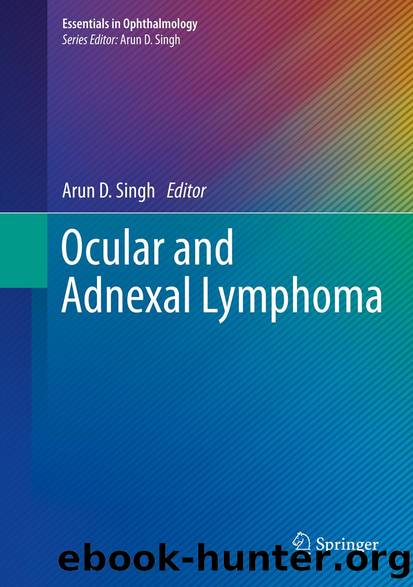Ocular and Adnexal Lymphoma by Arun D. Singh

Author:Arun D. Singh
Language: eng
Format: epub
Publisher: Springer Berlin Heidelberg, Berlin, Heidelberg
5.2.4 Ocular Adnexal Lymphoma
OAL encompasses a heterogeneous group of malignancies, the vast majority of which are of the non-Hodgkinâs type and are primarily of B-cell origin. Rarely, other forms such as T-cell (Ferry et al. 2007) and natural killer (NK)-cell lymphomas (Coupland et al. 1999; Mendenhall et al. 2006) can affect the ocular adnexal structures. The majority of OAL belong to one of five subtypes: EMZL, follicular lymphoma, DLBCL, mantle cell lymphoma, and lymphoplasmacytic lymphoma (Shields et al. 2001). Approximately 80 % are of the EMZL type (Freeman et al. 1972). Among affected sites, the frequencies of involvement are conjunctiva 20â33 %, orbit/lacrimal gland 46â74 %, and eyelid 5â20 % (Coupland et al. 2004; Knowles et al. 1990). Disease may be limited to a single, localized tumor, or it may be multifocal. Overlap with ocular adnexal sites is common (10â20 % of cases), and coexisting uveal involvement has been observed (Fuller et al. 2008). OAL can also affect regional, central, and peripheral lymph nodes as well as other distant extranodal sites.
OAL has a slight female predilection (60 % of cases in most series) (Shields et al. 2001). Individuals with OAL may present with a broad range of symptoms depending upon the site and extent of involvement. Common symptoms include a mass within the ocular adnexal structures, exophthalmos, ptosis, ophthalmoplegia, pain, decreased vision, or diplopia. If the lacrimal gland is involved, dry eye symptoms may occur. On clinical examination, OAL has site-specific presentations that affect how the diagnosis is made. In the conjunctiva, lesions typically present as a mass with a âsalmon patchâ appearance (Fig. 5.4). In the orbit, lacrimal gland, and eyelid, the lymphoma presents as a mass, which, if palpable, is typically firm. Mobility is variable depending upon attachment to other ocular adnexal structures. Diplopia may occur depending upon how rapidly the mass develops. Exophthalmos and decreased retropulsion of the globe may be the only clinical signs. Involvement of the nasolacrimal drainage system can occur. Compression or invasion of the optic nerve can lead to vision loss. Regardless of the clinical findings, these features do not allow distinction of benign from malignant lymphoproliferative disease.
Fig. 5.4Ocular adnexal lymphoma. Typical appearance of subconjunctival infiltrate presenting as âsalmonâ patch (a) and diffuse orbital extension without compression of the orbital structures (b). Bilateral asymmetric involvement (milder OS)
Download
This site does not store any files on its server. We only index and link to content provided by other sites. Please contact the content providers to delete copyright contents if any and email us, we'll remove relevant links or contents immediately.
When Breath Becomes Air by Paul Kalanithi(7264)
Why We Sleep: Unlocking the Power of Sleep and Dreams by Matthew Walker(5642)
Paper Towns by Green John(4169)
The Immortal Life of Henrietta Lacks by Rebecca Skloot(3826)
The Sports Rules Book by Human Kinetics(3588)
Dynamic Alignment Through Imagery by Eric Franklin(3489)
ACSM's Complete Guide to Fitness & Health by ACSM(3469)
Kaplan MCAT Organic Chemistry Review: Created for MCAT 2015 (Kaplan Test Prep) by Kaplan(3423)
Introduction to Kinesiology by Shirl J. Hoffman(3301)
Livewired by David Eagleman(3123)
The River of Consciousness by Oliver Sacks(2992)
Alchemy and Alchemists by C. J. S. Thompson(2912)
The Death of the Heart by Elizabeth Bowen(2901)
Descartes' Error by Antonio Damasio(2732)
Bad Pharma by Ben Goldacre(2730)
Kaplan MCAT Behavioral Sciences Review: Created for MCAT 2015 (Kaplan Test Prep) by Kaplan(2492)
The Gene: An Intimate History by Siddhartha Mukherjee(2491)
The Fate of Rome: Climate, Disease, and the End of an Empire (The Princeton History of the Ancient World) by Kyle Harper(2436)
The Emperor of All Maladies: A Biography of Cancer by Siddhartha Mukherjee(2431)
